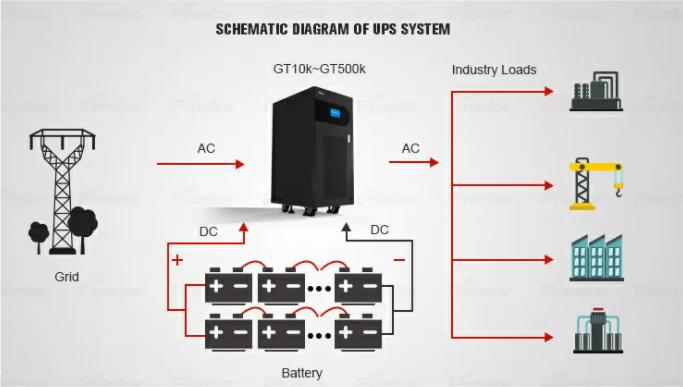What is a Low Frequency UPS?
A Low Frequency Online UPS is a sophisticated power protection device that utilizes double conversion technology to provide continuous and clean power to connected equipment. Unlike traditional Offline UPS, where the load is directly powered by the mains until a power failure occurs, it continuously powers the load through an inverter, ensuring a seamless transition between mains and battery power.
How Does It Work?
The UPS consists of several key components that work in tandem to deliver stable power:
Rectifier
The UPS takes in AC power from the mains and converts it into DC power using a rectifier circuit. This DC power charges the battery bank and powers the inverter.
Inverter
The inverter transforms the DC power from the battery into AC power, providing a clean and regulated output to the connected load. This continuous AC output ensures that the load is protected from any power fluctuations or disturbances in the mains supply.
Battery Bank
The battery bank acts as a backup power source. In the event of a mains power failure, the inverter draws power from the battery to sustain the load without any interruption.
Static Bypass
A static bypass switch serves as an alternative path for power to flow directly to the load from the mains if there is a fault or overload in the UPS system. This feature further enhances reliability and redundancy.

Advantages of Low Frequency Online UPS
Seamless Power Transition
The online double conversion technology guarantees an instantaneous transfer to battery power during power outages, ensuring critical equipment stays operational without any noticeable disruption.
Isolation from Power Quality Issues
It provides complete isolation from power quality issues, such as voltage spikes, surges, harmonics, and frequency variations. This protection is vital for sensitive electronic equipment susceptible to damage from such disturbances.
Constant Voltage and Frequency
The UPS regulates the output voltage and frequency, offering a stable and consistent power supply, which is crucial for delicate equipment and processes.
Improved Efficiency
While UPS systems are slightly less efficient than other UPS types, advancements in technology have narrowed the efficiency gap. The benefits of continuous power outweigh the marginal difference in efficiency for critical applications.
Applications
Data Centers
Data centers store and process massive amounts of critical information. A momentary power disruption could lead to data loss and costly downtime. It ensures continuous power supply, safeguarding data integrity and business continuity.
Medical Facilities
Hospitals and medical facilities rely heavily on uninterrupted power for life-saving equipment and patient care systems. It ensures critical medical devices remain operational even during power fluctuations or failures.
Industrial Processes
Many industrial processes, such as manufacturing and production lines, require a stable power supply to prevent costly downtime, product defects, and potential hazards to workers.
Financial Institutions
Banks and financial institutions heavily rely on real-time transaction processing.
A power outage during financial transactions could lead to severe monetary losses and erode customer trust.

High Frequency UPS VS Low Frequency UPS
The difference between high frequency and low frequency online UPS lies in the design and operating characteristics of the two systems. Let’s explore these differences:
Transformer Design
High Frequency Online UPS: It uses a high-frequency transformer, which is physically smaller and lighter. These transformers are known as ferrite transformers and are designed to operate at the higher frequencies of the system.
Low Frequency Online UPS: It utilizes a low-frequency transformer, often referred to as a laminated or iron-core transformer. These transformers are larger and heavier but are more efficient at the standard utility frequencies.
Efficiency
High Frequency Online UPS: UPS systems tend to have higher efficiency levels, especially during light loads. Their design with smaller transformers and other components contributes to reduced power losses.
Low Frequency Online UPS: It may have slightly lower efficiency compared to high-frequency UPS, especially at light loads. However, advancements in technology have narrowed the efficiency gap between the two types.
Output Voltage Regulation
High Frequency Online UPS: It typically provides excellent output voltage regulation, which is crucial for protecting sensitive electronic equipment from voltage fluctuations.
Low Frequency Online UPS: It also offers excellent voltage regulation capabilities, ensuring a stable output voltage, particularly during voltage fluctuations or disturbances.


